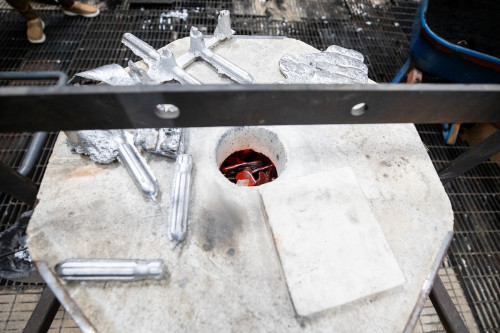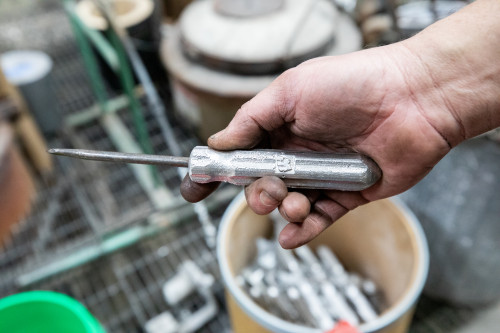College students compact sand round a mannequin to create the mildew cavity for a screwdriver deal with. Picture by Sarah Maughan/UW-Madison
Mechanical engineering college students gained sensible expertise casting screwdriver handles this fall within the Artwork Division’s foundry in a collaboration between the 2 departments.
For one week in October, the foundry was the classroom for ME 311 — Manufacturing: Metals and Automation, the place greater than 200 college students labored on creating the handles they’d designed.
On this course college students be taught processes for manufacturing metallic elements, together with casting. The curriculum focuses on designing elements to make them simpler to fabricate, with a watch towards growing productiveness.
Mike DeCicco, instructing college within the Division of Mechanical Engineering and the course’s lab coordinator, stated it’s essential for aspiring engineers — even those that don’t plan to work in a manufacturing atmosphere — to be taught the method of casting.
“Many merchandise are initially forged,” he stated. “It’s actually a elementary ability.”
Understanding elementary manufacturing processes similar to casting can assist college students design higher merchandise, he stated.
Frank Pfefferkorn, a professor in mechanical engineering and the course’s lecture teacher, agreed.
“College students achieve a greater understanding of a producing course of that’s used to supply virtually each metallic half in some unspecified time in the future in its manufacturing life cycle,” he stated. “This publicity will assist extra college students resolve if they’re excited by pursuing a profession at one of many 115 metallic casting amenities in Wisconsin or the 1,750 foundries in the US.”

An electrical kiln preheats aluminum blocks to take away moisture, earlier than they’re superheated to turn out to be molten. Later, the molten metallic is poured into the molds. Picture by Sarah Maughan/UW-Madison
College students stated the foundry expertise was enjoyable and enlightening.
“I personally love the hands-on aspect of engineering, so the entire ME 311 labs are enjoyable for me,” stated Aubrey Olson, a pupil within the course. “However this one was one in all my favorites, as a result of the method of constructing the mildew and seeing the half we made in the identical lab was actually satisfying.”
The train illustrates the overlap between engineering and artwork, she stated. “It jogs my memory that I will be artistic as an engineer as nicely.”

A completed screwdriver deal with forged within the Artwork Division foundry. Picture by Sarah Maughan/UW-Madison
The collaboration didn’t cease with ME 311. The Artwork Division’s foundry additionally hosted 16 college students from ME 601 — Superior Metallic Casting on Friday afternoons all through the autumn semester. These college students forged Wisconsin mugs, frying pans, and particular person designs utilizing aluminum.
Within the spring, college students excited by working with different metals can enroll in Artwork 414 — Artwork Foundry, which additionally consists of initiatives utilizing bronze.
Leslie Smith III, Artwork Division chair, expressed enthusiasm for the partnership’s potential to foster interdisciplinary collaboration. He recommended the potential of cross-listing programs between the departments.
“Proper now, we’re simply within the trial-and-error mode of determining what works, what doesn’t work, and the way we’d have the ability to advance this collaboration when it comes to figuring out a united house that matches the wants of each departments,” he stated.
Smith added: “We wish to create an area the place artists and engineers can cohabitate and make college students conscious of how they will advance their data within the house by means of a special lens.”






























































